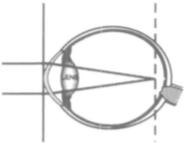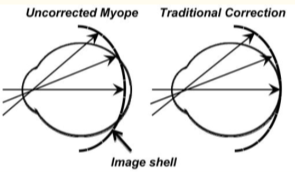Myopia (short-sightedness) is the most common eye condition in the world1. In a myopic eye, the refractive power of the cornea and lens causes light rays from distant objects to form a focus in a plane in front of the retina (Figure 1), due to increased axial length (AL) of the eye caused by expansion of the posterior vitreous chamber2. Myopes (usually classified when spherical equivalent (SE) <-0.5DS1,3) therefore experience blur in the distance, and require refractive correction to push the focal plane posteriorly, so it coincides with the AL, and the image is formed on the retina.

Figure 12. Myopic eye. AL and refractive power are out of step, so light rays refracted by the cornea and lens come to a focus anterior to the retina. The resultant blurred retinal image requires optical correction.
As well as a refractive impairment, myopia is progressively being considered as a disease3. The abnormal lengthening of the eye isn’t corrected by the use of optical devices or surgery and is considered pathologic, being implicated in many irreversible, sight threatening conditions, especially in high myopia (usually defined as SE <-6D2,3). The complications of high myopia include myopic choroidal neovascularization, presenile cataracts, myopic maculopathy, staphyloma, glaucoma and retinal holes, tears and detachment3-5. Pathological myopia causes 3% of visual loss worldwide5.
The prevalence of myopia varies across the world depending on age group, ethnicity, geographical location, extent of urbanisation of residing areas and possibly gender.
The prevalence of myopia in childhood and adolescence is particularly important as the earlier myopia develops, the greater the risk of high myopia and pathology later in life3. Myopia prevalence in children and adolescents is reaching epidemic levels in East Asia6, and is rising, with 80% of East Asians being myopic by the age of 187. Amongst East Asians, myopia rates are highest in those in Singapore, followed by Hong Kong and Taiwan and lower in those in China and Australia7. Myopia levels in Europe are lower, but are increasing, at a similar rate to those in North America4 and in the UK the number has doubled in the last 50 years amongst white 10-16 year olds8. There is evidence for higher myopia rates in more urbanised areas7 and some studies show higher rates in females than males8,9.
This overall increase in myopia, and high myopia prevalence is a global health concern with implications for public health policy and the economy10,11, so understanding its aetiology is important if we hope to successfully manage myopia in the future.
Myopia has been shown to have both a genetic and environmental aetiology. Myopia is hereditary12, with children more likely to be myopic if both parents are myopic compared to if one or neither are myopic13. A recent meta-analysis identified 161 gene loci associated with myopia inheritance14 and highlighted how genetics and environment interact to influence myopia development14,15. Increased time spent outdoors is associated with a later onset of myopia, a lower myopic refraction and slower developmentdue to promoting greater viewing distances, causing reduced image blur and increasing the release of dopamine16,17.
Recent research has implicated the role of hyperopic defocus in the peripheral retina as playing a role in the development of myopia. AL elongation in the eye is regulated by localised visual feedback mechanisms across the whole retina, whereby image blur stimulates growth, resulting in a more myopic SE18. The elongated AL of myopic eyes makes them prolate in shape, so the retina is steeper (less myopic) in the periphery19. This means spherical image shells formed by refraction do not follow the full retinal contour and create hyperopic blur in the periphery18 (Figure 2). Some studies have shown that peripheral retinal exposure to this hyperopic defocus, stimulates the eye to grow further, leading to myopia progression. Some research also suggests that peripheral retinal feedback is even more important than central retinal feedback in controlling AL growth and thus refractive development20.

Figure 220. Hyperopic blur in myopic eyes. In an uncorrected myope, the AL is elongated and the spherical image shell falls short of the retinal fovea, resulting in central myopic blur, but is flatter at the periphery, resulting in localised areas of hyperopic blur. In a traditionally corrected myopic eye, the spherical image shell is pushed back onto the retinal fovea, but the peripheral retina is still hyperopically blurred. The hyperopic blur in both cases may stimulate further AL growth.
This dissertation will look at current theories of myopia and its management, examine evidence for and against the hyperopic defocus theory in myopia and whether myopia management involving appropriate peripheral correction based on this theory should be implemented in clinical practice.
References
1. Leo, S. and Young, T. (2011). An evidence-based update on myopia and interventions to retard its progression. Journal of American Association for Pediatric Ophthalmology and Strabismus, Vol 15, Issue 2, 181-189.
2. Norton, T. (1999). Animal Models of Myopia: Learning How Vision Controls the Size of the Eye, ILAR Journal, Vol 40, Issue 2, 59–77.
3. Wu, P., Huang, H., Yu, H., Fang, P. and Chen, C. (2016). Epidemiology of Myopia. Asia-Pacific Journal of Ophthalmology, Vol 5, Issue 6, 386-393.
4. Williams, K., Bertelsen, G., Cumberland, P., Wolfram, C., Verhoeven, V., Anastasopoulos, E., … Hammond, C. (2015). Increasing Prevalence of Myopia in Europe and the Impact of Education. Ophthalmology, Vol 122, Issue 7, 1489-1497.
5. Wong, T., Ferreira, A., Hughes, R., Carter, G., Mitchell, P. (2014). Epidemiology and Disease Burden of Pathologic Myopia and Myopic Choroidal Neovascularization: An Evidence-Based Systematic Review. American Journal of Ophthalmology, Vol 157, Issue 1, 9-25.
6. Wong, Y., Saw, S. (2016) Epidemiology of pathologic myopia in Asia and worldwide. Asia Pacific Journal of Ophthalmology. Vol 5, Issue 6, 394-402.
7.Rudnicka, A., Kapetanakis, V., Wathern, A., Logan, N., Gilmartin, B., Whincup, P., … Owen, C. (2016). Global variations and time trends in the prevalence of childhood myopia, a systematic review and quantitative meta-analysis: implications for aetiology and early prevention. British Journal of Ophthalmology, Vol 100, Issue 7, 882–890. doi:10.1136/bjophthalmol-2015-307724
8. McCullough, S., O’Donoghue, L., Saunders K. (2016) Six year refractive change among white children and young adults: evidence for significant increase in myopia among white UK children. Plos One. Volume 11, Issue 1.
9.. Kempen, A., Mitchell, P., Lee, K., Tielsch, J., Broman, A., Taylor, H., … Friedman, D. (2004). The prevalence of refractive errors amongst adults in the United States, Western Europe, and Australia. Archives of Ophthalmology. Vol 122, Issue 4, 495-505.
10. Zheng, Y., Pan, C. Chay, J., Wong, T., Finkelstein, E., Saw, S. (2013). The economic cost of myopia in adults aged over 40 years in Singapore. Invest Ophthalmol Vis Sci. Vol 54, Issue 12, 7532–7537.
11. Vitale, S., Cotch, M., Sperduto, R., Ellwein, L. (2006) Costs of refractive correction of distance vision impairment in the United States, 1999–2002. Ophthalmology. Vol 113, Issue 12, 2163–70.
12. Young, T. (2009). The molecular genetics of human myopia. Optometry and Vision Science. Vol 86, Issue 1, 8-22.
13. Jones-Jordan, L., Sinnott, L., Manny, R., Cotter, S., Kleinstein, R., Mutti, D., … Zadnik, K. (2010). Early childhood refractive error and parental history of myopia as predictors of myopia. Investigative ophthalmology & Visual science. Vol 51, Issue 1, 115-121.
14. CREAM. (2018).Genome-wide association meta-analysis highlights light-induced signaling as a driver for refractive error. Nature Genetics. Vol 50, Issue 6.
15. Jones, L., Sinnott, L., Mutti, D., Mitchell, G., Moeschberger, M., Zadnik, K. (2007). Parental history of myopia, sports and outdoor activities, and future myopia. Investigative Ophthalmology & Visual Science. Vol 48. Issue 8, 3524-3532.
16. Rose, K., Morgan, I., Ip, J., Kifley, A., Huynh, S., Smith, W., Mitchell, Paul. (2008). Outdoor activity reduces the prevalence of myopia in children. Ophthalmology. Vol 115, Issue 8, 1279-1285.
17. Wu, P., Tsai, C., Wu, H., Yang, Y., Kuo, H. (2013). Outdoor activity during class recess reduces myopia onset and progression in school children. Ophthalmology. Vol 120, Issue 5. 1080-1085.
18. Stone, R., Flitcroft, D. (2004). Ocular shape and myopia. Annals, academy of medicine, Singapore. Vol 33, Issue 1, 7-15.
19. Schmid, G. (2003). Variability of retinal steepness at the posterior pole in children 7-15 years of age. Current Eye Research. Vol 27, Issue 1, 61-68.
20. Smith, E. Prentice Award Lecture 2010: A case for peripheral optical treatment strategies for myopia. Optometry and Vision Science. Vol 88, Issue 9, 1029-1044.
You have to be 100% sure of the quality of your product to give a money-back guarantee. This describes us perfectly. Make sure that this guarantee is totally transparent.
Read moreEach paper is composed from scratch, according to your instructions. It is then checked by our plagiarism-detection software. There is no gap where plagiarism could squeeze in.
Read moreThanks to our free revisions, there is no way for you to be unsatisfied. We will work on your paper until you are completely happy with the result.
Read moreYour email is safe, as we store it according to international data protection rules. Your bank details are secure, as we use only reliable payment systems.
Read moreBy sending us your money, you buy the service we provide. Check out our terms and conditions if you prefer business talks to be laid out in official language.
Read more